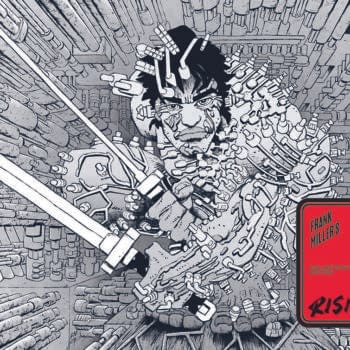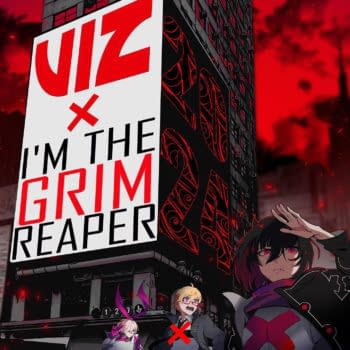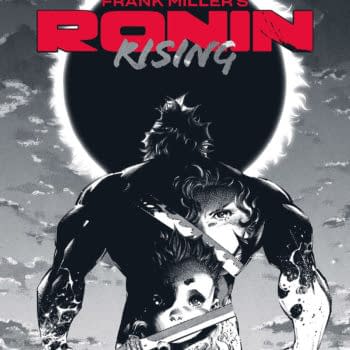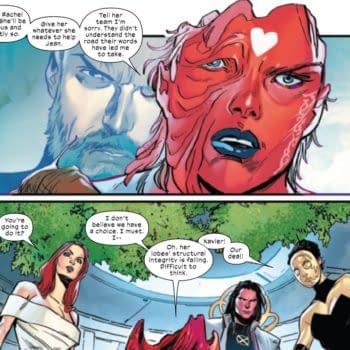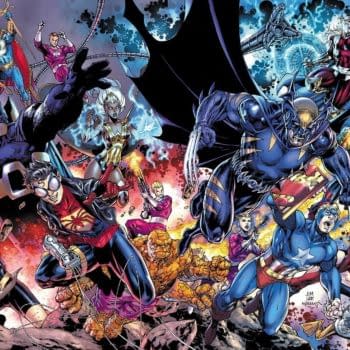Posted in: Comics, Recent Updates | Tagged: agent carter, captain america, Comics, entertainment, Marvel Comics, shield
Thor's Comic Review Column – Miracleman #2, Captain America: White #1, S.H.I.E.L.D. 50th Anniversary: Agent Carter #1
This Week's Reviews:
Miracleman #2
Captain America: White #1
S.H.I.E.L.D. 50th Anniversary: Agent Carter #1
Miracleman #2 (Marvel, $4.99)
By Cat Taylor

While Gaiman's first issue was one complete adventure, this time he tells one main story with two shorter back-ups. The primary feature in this issue is "Skin Deep." It's a modern retelling of the Greek legend of Eros and Psyche, with Miraclewoman in the goddess role and a windmill worker as the mortal. Like the Greek legend, the main plot involves the windmill worker's obsession with perfection in romance. If you already know the old myth, or even if you've ever read any other stories, you have a pretty good idea that there is a moral here about the folly of pursuing perfection. Although, what I found that made this one even more interesting is how the story is also a reflection of Miracleman's utopian earth in general. This is evidenced in the first few pages where the windmill worker laments the old forests and the wolves that have become extinct to make room for a wind-powered planet. He's living in what should be a perfect world, yet he misses things as they were before Miracleman's divine intervention. Even though Gaiman is never short on ideas from fables and legends, as he proved with Sandman, I suspect that the larger angle in Gaiman's Miracleman will ultimately be mankind's dissatisfaction with this heaven-on-earth.
The second story in this issue is called "Trends" and it's a more light-hearted tale about a group of kids standing around the schoolyard talking to one of their classmates about his membership in a cult that worships the deceased and evil Kid Miracleman. The conversation is treated as lightly as the kids in Archie talking about a football game. Mark Buckingham's art in this section is tailored for that effect, looking like a conglomeration of various characters from the Sunday funnies. While the overall more comical approach is fitting, his wildly inconsistent style from one kid to the next pretty distracting since each character looks like he or she came from completely different comics. At any rate, in this story like the previous, one of the kids throws in a comment about how boring things have become since Miracleman made everything so perfect. Once again, it's a small piece that seems fairly insignificant, but in the larger scheme of things I am quite certain that it will prove to be the main element of this run.
Finally, the last feature in this book is "Retrieval". It's a wordless two page story and I honestly have no idea what it means. Buckingham's art is much more detailed here than in either of the two preceding tales and he has drawn what is apparently a spaceship and several bizarre creatures, among other things, floating around. Whatever is happening here, it's to be continued. So, maybe I'll figure it out in the next issue.
Needless to say, I'm not shy about my fandom of Gaiman. Therefore, it's surprising to me that I didn't read his run on Miracleman when it was originally published, but I'm glad to have the opportunity to do so now. In addition to picking up similarities to the way he wrote for Sandman, the other thing I've noticed is how similar his handling of this comic is to the way Kurt Busiek wrote Marvels. Both focused on civilians, with the heroes as background plot devices. Perhaps not so coincidentally, both comics turned out some brilliant results. Also, even though I am already an established Buckingham fan, thanks mostly to his runs of Hellblazer and Fables, I found myself even more impressed with the fact that he was able to effectively use a different art style for each story in this issue. I know I mentioned being bothered by the inconsistencies in the styles he used to draw characters in "Trends," but that's truly the only place where I felt his versatility was not used to its advantage. In conclusion, I'm beyond thrilled that Marvel is continuing to reprint the old Miracleman comics. I don't know what they have planned when they run out of Gaiman stories, but since they've reprinted all the Alan Moore issues, the only way I could be happier is if they commission Busiek to write some new ones. If this were a perfect world, Miracleman himself could make that happen.
Cat Taylor has been reading comics since the 1970s. Some of his favorite writers are Alan Moore, Neil Gaiman, Peter Bagge, and Kurt Busiek. Prior to writing about comics, Taylor performed in punk rock bands and on the outlaw professional wrestling circuit. He thinks that he would have been a great Chippendale's dancer. You can e-mail Cat at cizattaylor@hotmail.com.
Straight Outta Cryo-Sleep – Is Captain America White #1 Worth the Wait?
By Adam X. Smith

However, it's not my job to defend Jeph Loeb's record as a writer. My job is to tell you whether or not Captain America White, the fourth volume in Loeb and Sale's Colours Trilogy (guess that makes it a Quartet now), was worth the nearly decade long wait.
And the answer is a cautious… maybe?
Back in the early 2000s, when the Colours Trilogy first came out in the form of Daredevil Yellow, Spider-Man Blue and Hulk Gray, the connection between the varying thematic, visual and storytelling elements was very clearly delineated. In each one, a framing device has the protagonist reminiscing sadly about a lost loved one – Karen Page, Gwen Stacy and Betty Ross respectively* – .with the artwork of the framing device taking place mostly in black and white with Sin City-esque splashes of colour in minor details, like Daredevil's iconic red costume picked out against the rooftops of Hell's Kitchen or the bold gamma-green of Bruce Banner's eyes as he tries to rein in the anger within; this gave significant contrast to the art-style of the books proper, which were modelled on the earliest appearances of those characters but with Sale's distinctive ink-washed look, achieved through his collaboration with colourist Dave Stewart due to Sale's colour-blindness.
Cap White's opening pages, which depict Cap waking from the iceberg, encountering the Avengers for the first time and reuniting with former comrade/foil Nick Fury, has bizarre transitional qualities to the art, with the Avengers pages looking almost as if they were meticulously pencil-coloured and the Fury pages, taking place in a benighted chapel with Sale's signature use of shadows and black-out detailing, is highly reminiscent of his work on Batman. The pages of Cap and Bucky fighting in the desert and acting as Big Damn Heroes to a pinned down Fury and Dum Dum Dugan, and the sequence in a nightclub bar that could have been lifted directly from Casablanca, are much more consistent visually and whilst the issue felt a little light, it didn't outstay its welcome and the inclusion of the material from the zero-issue felt like a decent compensation for anyone who didn't pick those up the first time round.
There's definitely an effort made here to distinguish Steve Rogers' relationship with Bucky from the likes of Batman and Robin, particularly the fact that Steve and Bucky are, as in the recent films, depicted as a lot closer to each other's ages than their physical attributes would indicate – the fact that Bucky has more experience than Steve with girls and, despite his boyish looks, still needs to shave is deliberately pointed out.
It's also telling that, whilst the other Colours books tend to focus on lost love interests, Loeb's signature internal monologue captions focus not on his loss of Peggy Carter but on Bucky. Given that its delayed release has meant that an equally definitive iteration of the origins of their relationship is part of the collective consciousness, it seems like an odd choice. But as Loeb notes in the interview material, even the strongest soldier can still feel the reality of what they are doing, and the weight of Bucky's death up to the events of the Winter Soldier is very much symbolic of perhaps the greatest failure any hero has to come to terms with – with the best will in the world, Steve can't save everyone, not even those closest to him.
Whether or not Loeb and Sale can justify parsing this out over the five issues set to make up this miniseries, there is something refreshing about reading one of their books, especially one yanked out of years of limbo much like Cap himself. Certainly after so long out of the game, it is easy to shrug cynically at something so old-fashioned, but in the words of a certain SHIELD agent, its times like these we could all use a little old-fashioned.
*As a matter of historical record, whilst Gwen Stacy's iconic death in the Seventies was such an epochal moment that it essentially marked the end of the Silver Age, at the time of the Trilogy's writing, Karen and Betty's deaths were relatively more recent and in spite of them having pivotal roles in their respective books for many years, their deaths were relatively recent and yet relatively obscure to me. Perhaps this was a side-effect of how many female characters were getting fridged in the name of amping up the drama. And yeah, I know Betty Ross's death was retconned – I'm still counting it as a death though since at the time and in the canon it's treated as such.
Adam X. Smith sent a letter in to the creators of Sex Criminals urging them to commit an act of guerilla warfare against the GOP by firing copies of their book out of a mortar cannon at the next debate. If it sees print, he will be highly impressed. He's currently mentally preparing for his Masters degree and phase 2 of Project Diamond Authority, so communiques will be a little scattered for a while.
S.H.I.E.L.D. 50th Anniversary: Agent Carter #1
By Jeb D.

Immonen's characterization of the two women is fine—she knows both characters very well at this point, as Peggy proceeds briskly from irritation at Sif's "fish out of water" act to bonding with the Asgardian—and they do have some nice dialog exchanges. But there's also a sense that the pairing is pretty gimmicky; among other things, the 1966 Peggy, and Dum-Dum Dugan, don't really acknowledge the passing of decades since their wartime adventures, and rather than, say, retcon Peggy with the Nick Fury immortality serum (which the Captain America films suggest hasn't happened), it would have been nice to get a sense of how different explosive adventuring looks and feels to a middle-aged Agent Carter. Instead, it just reads like a more or less random mashup of two familiar characters, linked only by the fact that Immonen's written both in the past.
Rich Ellis' art (with color from Rachel Rosenberg) has a light, cartoony touch that evokes something of the 1966 setting (though it's closer to, say, 70's era Romita or Buscema than to a Steranko SHIELD comics), but undercuts the script's climactic attempts at drama.
It's almost a spoiler for me even to say that I don't want to give away spoilery details about the plot of this comic, since the whole point of the exercise is to try to turn our expectations upside down, in the mildest possible way; let me just say that if, as you're reading these life-and-death heroics of Peggy Carter and Lady Sif, you were imagining what the cheesiest "out" for the ending could possibly be, you'd be right on (well, not quite; I will give Immonen this: it's not a dream sequence).
A writer of Immonen's gifts could have spun a pretty good "mismatched partners" yarn with these two women, if the story were given a few issues to breathe; not only is the over-tidy ending a bit of a shrug, but it pretty much forestalls the chance of expanding on that relationship: the development between the two characters that could have intrigued a reader over the course of several issues just feels tossed-off when everything is resolved in a few pages. Peggy and Sif might yet have adventures together, but they've already zipped through the most potentially interesting one.
Jeb D. works for a nonprofit legal services firm. He has yet to figure out how to make comics part of his job.










